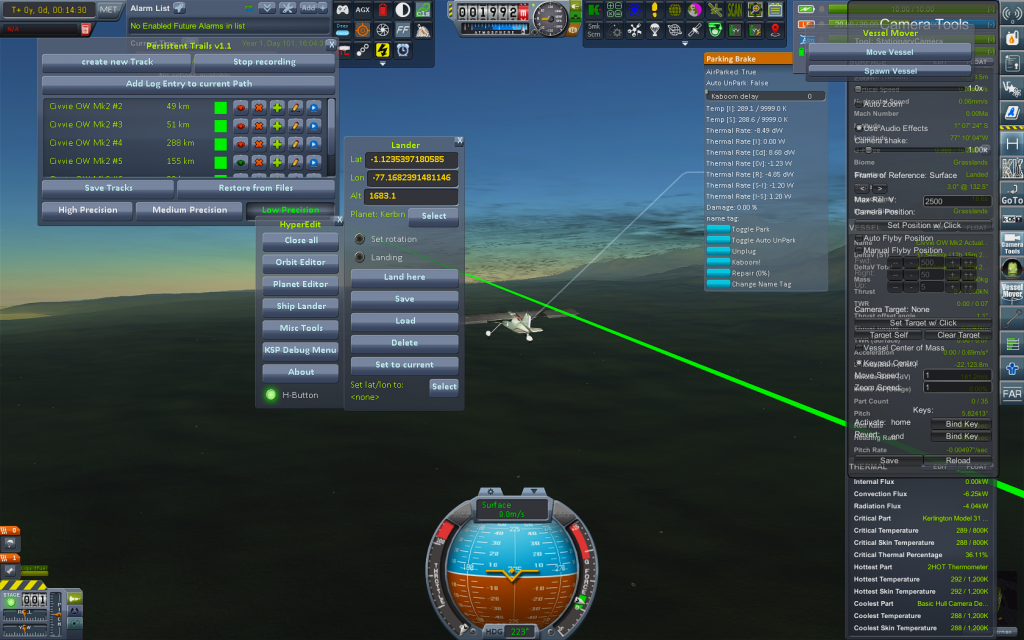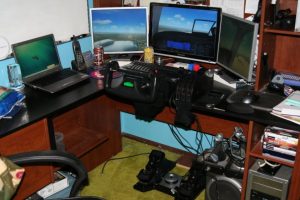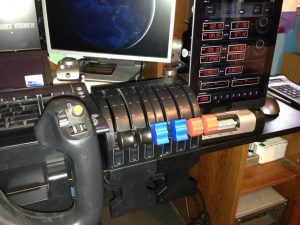|
Progenitor Program Moves to Phase 3
Which is another way of saying the Progeny Mk3 rocket is ready to be debuted at the start of our operations next year in 2017. Progenitor Program scientists and engineers have been working hard on the Progeny Mk2.1 data all week to finalize their plans for the Progeny Mk3. All we will say right now is that it will aim to break our next altitude goal of 10km, and possibly higher. We don’t expect to reach space until our liquid fuel rocket arrives for Phase 4 and none of these rockets are expected to make orbit – that will be a totally different rocket program. Phase 5 of the Progenitor Program will focus on rocket control for internal systems when out of range of KSC communications.
If you haven’t already, do check out the report released earlier this week that went into more detail about the timing of the second stage booster and how the different coast times affected the apokee of the rocket.
Civvie Prototype Passes Trials, Production Model Next
C7 engineers are very pleased with the data that was gathered during the various trial missions of the Civvie prototype by Commander Valentina and Captain Jebediah this past week. The biggest problem the prototype has was its sideslip issues causing a large amount of yaw during level flight and turns, which was corrected by attaching a taller vertical stabilizer. Even during Jeb’s first flight the sideslip very rarely surpassed 5° in either direction and did not exceed 10°. The production model of the Civvie will have a longer tail boom, which will give the rudder a greater amount of torque effect for better control authority in this region. The production model will also have better handling and flight performance since it will be built much, much lighter than the prototype. This means it will not withstand crashes nearly as well, but flight data have shown that under the right operating conditions the Civvie is a real joy to fly and handles great in stalls, dives, steep turns and apparently can even pull off a vertical loop (not to be recommended in the Pilot’s Operating Handbook). Landing posed various issues for both pilots but the lighter weight of the production version will take a lot of load off the undercarriage suspension, which will help greatly.
The production model will begin construction in the HAB when we return to operations in January. The prototype will be used at the start of the year for several more science flights and then be flown to Kravass City for its retirement in the Air History Museum.
KerBalloon Probes Ready to Soar Higher
We’ve finally run through our entire stock of 10 KerBalloon units that were shipped to us back at the start of November with a final mission this week. Various contracts were satisfied, although we are still not sure what happened to the one unit that sank at sea after splashdown. The MSV did not reach it for some time so it could have just been in the water too long and a small crack in its casing that wasn’t noticed during final integration could have taken on enough water for it to sink. KerBalloon assures us they are doing their own tests to ensure a properly-built unit can stay afloat for several hours after landing. Overall though the KerBalloons performed with great quality and consistent results.
Next year we will be receiving a shipment of our regular standard KerBalloon units but also taking delivery of a smaller sample of high-altitude balloon units for testing. These new balloons are made of a lighter, more flexible material that can expand further without ripping or tearing, which is the fate of the current balloons and the reason they are unable to make it out of the lower atmosphere. Scientists are hoping these new balloons can open up the upper atmosphere (>18km) to researchers. Both units will come equipped with their own parachutes as well, which will reduce part use between the KerBalloon and Progenitor programs as the rocket nose cone chute will no longer be needed by both.
KSA Archives Online
If you’ve been lagging behind on goings-on at the KSA then the best place to catch up on everything would be the Historical Archives section of the website, where you can access images, videos, mission logs, tweets, and more.
Celestial Snapshot of the Week
Eve and Sarnus, two of the brightest objects in the night sky, came together this week and of course Val was ready. They look the same size but Sarnus is in fact still a little bit bigger in this image, though not by much. Also visible is Gilly near apoev at the bottom and the three Sarnus big moons of Eeloo, Slate and Tekto.
From the Desk of Drew Kerman
Out of Character Behind the Scenes stuffWritten on 12/2/16
This past week or two was very rough. A lot of it was spent on real-life stuff like Thanksgiving and insulating my office against the cold weather that is now encroaching. But I’m nice and toasty warm now so it was worth it – trust me typing with cold, cramped fingers sucks. You’ll note that I’m writing this in Decemeber and the KSA is still in December – not good. But I’ve had to get through a bunch of new experiences in flying aircraft in KSP and had to develop several new techniques for doing things. Hopefully with all that now streamlined I can recoup the lead time I’ve lost.
Reliving the Flights
One of the biggest new techniques I’ve devised is how to fly an aircraft with minimal graphics settings, then go back for photos of the flight with maxed-out graphics settings. I have a decent computer but still, running high-res graphics with all the mods I have installed takes a toll, and I’m generally getting 17-20 FPS with a constant yellow time, which means physics ticks are being dropped and I don’t like that. Plus reducing the graphics and upping the framerate makes for a more enjoyable and responsive flying experience (I’m still on v1.1.3 so the garbage collection snags remain an annoyance though).
So the technique combines several mods: HyperEdit, VesselMover, Persistent Trails, Kerbal Engineer Redux (KER) and AirPark. It goes like this:
- Record the flight on video
- Choose a point in the flight video I want to take a photo – make note of the Lat, Lng and AGL from KER
- Convert the Lat/Lng from degrees/min/sec to decimal (honestly don’t know why KER shows it in this format)
- Show the trail of the flight made by Persistent Trails
- Plug the location and altitude into HyperEdit’s vessel lander and toggle the landing
- Use the I,J,K,L keys to fine tune the position of the aircraft to fall on/near the trail
- Activate the AirPark anchor when on/near the trail to freeze the vessel in place
- Activate VesselMover, which doesn’t let me move the vessel’s location (because AirPark is active) but does let me orient the vessel properly with the Q,E,I,J,K,L keys
- Use the HyperEdit misc function window to set the game to the proper UT time
- Remove all UI elements and take a screenshot
Here’s what it looks like in action:
 Using this technique I can closely if not exactly match the location (Lat, Lng, Alt) and orientation (pitch, roll, yaw) of the aircraft in order to get a photo. Now that I have the method down, it goes pretty quick jumping around for photos. This is how I got all the external camera views of the last two Civvie flights.
Using this technique I can closely if not exactly match the location (Lat, Lng, Alt) and orientation (pitch, roll, yaw) of the aircraft in order to get a photo. Now that I have the method down, it goes pretty quick jumping around for photos. This is how I got all the external camera views of the last two Civvie flights.
Wheels – I Screwed Up
So I finally realized what I was doing wrong with the wheels – I was overburdening them with the excess weight of the Civvie because I never tweaked down the wing strength. So it was too heavy for them. Adjusting the springs to their max made things much better, but still a bit difficult. Really, I should have tweaked down the wing strength and lightened the Civvie to the point where the wheels functioned well under their max spring settings. For some reason I thought the wheels auto adjusted to the weight that they were bearing when the craft was launched – pretty sure I read something to that extent in the dev notes prior to v1.0 but I guess something changed, or I didn’t interpret it properly. Anyways, lesson learned!
This also means pretty much all the landings I showed on the runway were “faked” to some extent. I mean yes I did actually come in at the speeds that were posted on twitter but the wheels on the runway were rather temperamental and, well… there was flipping. Nothing major that broke the aircraft but still a few tumbles that I didn’t feel were proper given the approaches I made. So they didn’t happen. I can’t and won’t let everything that goes on in the game dictate how the story plays out.
Yay Flying Again!
It was a lot of fun to break out the Saitek X52 and fly around. I’ve been a huge Microsoft Flight Simulator fan practically my whole life, since my uncle introduced me to FSII from SubLogic, what would eventually become MSFS. This was my flight sim setup prior to starting to really play KSP:
I still have all those controls and also have a Saitek Rhino X55 for dual-engine jets. I mainly use the joysticks only for KSP tho – setting up the yoke, throttle and rudder pedals is a bit of a pain.
So yea, I have a lot of experience flying single-engine propeller planes and I put that to good use putting the Civvie through its paces and all the terminology and approach work seen this past week. Good times. I still miss FSX though, and do continue to keep tabs on the flight simulation community.
Inventory Shortage
In a previous Desk Notes I showed how I keep track of what parts I have available. Well funny story is that this month I almost screwed up when I wrote that science instruments were being installed on the Civvie. Thankfully I didn’t note specifically which ones but I had planned to do temperature and barometer. However the KSA only ever had two and one of each was lost when the KerBalloon sank and the other ones were being used the same day for a KerBalloon probe. Rather than switch over to using the Aeronomy and Meteorological packages from the rockets, I just decided to include an order for replacement instruments earlier in the month on the finance sheet so I could use them in the Civvie. Yea, stuff like that happens and I need to retcon a little 😛
“Same Yet Different” Challenge
The one thing that is challenging about repetitive events (this applied to the Progeny Mk2.1 launches as well) is making them interesting each time. I mean sure the Civvie was doing different things in the air but when it came to landing and taking off a lot of that is pretty routine. So finding ways to shake things up (like forcing the Rwy27 water approach and bringing in the MSV) and even finding new angles to capture images, is a constant challenge. The main objective is to never quite cover how things are happening more than 2-3 times the exact same way – hopefully never the exact same way. And it’s not just the images but the way things are tweeted, finding new ways to describe similar events. I enjoy that challenge from a writing perspective, and the 140 character limit and my personal limit of 2-3 tweets about the same event increase the challenge. Very enjoyable.
Vacation Time! Wait, No…
So now the KSA is on operations break, but that doesn’t mean I get to just jump ahead a few days unfortunately. I still need to timewarp through all the days so asteroids are generated, and the ATN isn’t on break so I will need to collect any new asteroid data that comes up for each day during the break, and maybe make note of significant celestial events or asteroid events that occur during that time. Meeny orbital data needs to be updated and new system charts published as well. So I still have a good deal of work to do during the “vacation” but it will definitely be a lot less than normal and get me closer to being one month or more ahead of things again. Onward!










